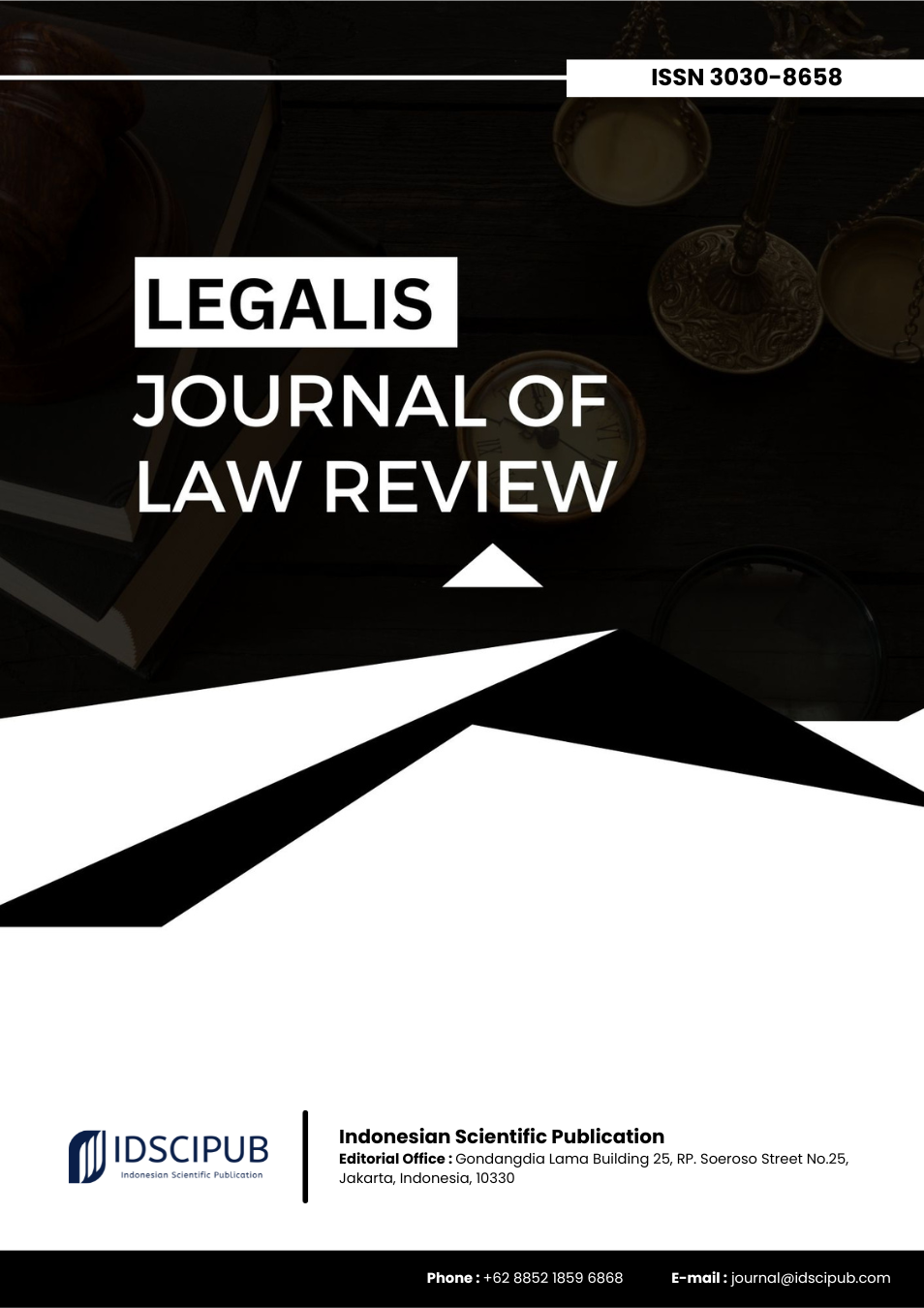Breaking Default Bias: How Regulatory Choice Architecture Shapes Competition in Platform Ecosystems
DOI:
https://doi.org/10.61978/legalis.v3i3.1126Keywords:
Digital Markets Act, Interoperability, Switching Costs, Default Bias, Competition Law, Consumer Welfare, InnovationAbstract
This article examines how default bias and switching frictions reinforce platform dominance and whether regulatory interventions can reduce these barriers. The research employs a difference-in-differences framework combined with event-study analysis to measure the causal effects of DMA obligations on user switching. Data sources include browser adoption statistics, app store analytics, and compliance monitoring reports from the European Commission. Key outcome variables include browser switching rates, alternative browser market shares, and adoption of link-out billing systems. The introduction of DMA choice screens resulted in a marked increase in consumer switching, with browser switching rates rising from 8.5% to 13.2%, demonstrating the policy’s effectiveness in breaking consumer inertia associated with defaults and alternative browser shares increasing from 19.6% to 24.5%. Link-out billing adoption grew from 2.1% to 8.3%. Cross-country heterogeneity reveals that countries with high digital literacy and strong infrastructure, such as Germany and the Netherlands, saw stronger switching effects compared to southern European countries with entrenched default reliance. The discussion highlights the role of behavioral economics in designing effective choice screens, the challenges posed by dark patterns, and the comparative advantages of interoperability mandates over structural remedies in fostering sustained competition. The analysis underscores that interoperability lowers switching costs, enhances contestability, and incentivizes platforms to innovate, thereby benefiting consumers and promoting long-term market dynamism. The study concludes that ex ante regulatory mandates under the DMA are effective in reducing consumer lock-in and reshaping digital market dynamics. However, regulatory vigilance is essential to prevent circumvention through manipulative design practices. The findings contribute to ongoing policy debates on digital regulation, emphasizing the need for adaptive, user-centered governance frameworks that balance competition, innovation, and consumer welfare.
References
Atasoy, A. T., & Madlener, R. (2020). Default vs. Active Choices: An Experiment on Electricity Tariff Switching. SSRN Electronic Journal. https://doi.org/10.2139/ssrn.3662969 DOI: https://doi.org/10.2139/ssrn.3662969
Berg, T., Burg, V., Gombović, A., & Puri, M. (2019). On the Rise of FinTechs: Credit Scoring Using Digital Footprints. Review of Financial Studies, 33(7), 2845–2897. https://doi.org/10.1093/rfs/hhz099 DOI: https://doi.org/10.1093/rfs/hhz099
Bostoen, F. (2023). Understanding the Digital Markets Act. The Antitrust Bulletin, 68(2), 263–306. https://doi.org/10.1177/0003603x231162998 DOI: https://doi.org/10.1177/0003603X231162998
Couto, J., Maanen, L. v., & Lebreton, M. (2020). Investigating the Origin and Consequences of Endogenous Default Options in Repeated Economic Choices. https://doi.org/10.1101/2020.04.15.042689 DOI: https://doi.org/10.1101/2020.04.15.042689
Donkers, B., Dellaert, B. G. C., Waisman, R., & Häubl, G. (2020). Preference Dynamics in Sequential Consumer Choice With Defaults. Journal of Marketing Research, 57(6), 1096–1112. https://doi.org/10.1177/0022243720956642 DOI: https://doi.org/10.1177/0022243720956642
Fletcher, A., & Vasas, Z. (2024). Implications of Behavioural Economics for the Pro-Competitive Regulation of Digital Platforms. Oxford Review of Economic Policy, 40(4), 808–817. https://doi.org/10.1093/oxrep/grae044 DOI: https://doi.org/10.1093/oxrep/grae044
Frank, M., & Lewis, E. G. (2024). The European Commission’s Challenge to Consent or Pay: Demystifying the Digital Markets Act? World Competition, 47(Issue 4), 427–452. https://doi.org/10.54648/woco2024026 DOI: https://doi.org/10.54648/WOCO2024026
Goda, Y. (2022). Regulatory Science of Natural Products. Journal of Natural Medicines, 76(4), 732–747. https://doi.org/10.1007/s11418-022-01639-w DOI: https://doi.org/10.1007/s11418-022-01639-w
Gunawan, A. (2021). Analysis of Regional Health Expenditure in Indonesia. Journal of Public Finance, N/A(N/A), N/A-N/A.
Henley, W. H., Ranganathan, S. K., & Gurtu, A. (2018). Improving Effectiveness of Public Service Advertisements to Prevent Texting and Driving of American Youth. International Journal of Nonprofit and Voluntary Sector Marketing, 23(4). https://doi.org/10.1002/nvsm.1626 DOI: https://doi.org/10.1002/nvsm.1626
Herath, U. R., Silva, D. I. D., Godapitiya, V., Arachchige, P. N. W., Gedara, H. K., & Premadasa, R. (2023). A Comparative Study of Different Software Complexity Metrics in Measuring Software Interoperability. Indian Journal of Software Engineering and Project Management, 3(2), 1–4. https://doi.org/10.54105/ijsepm.b7652.073223 DOI: https://doi.org/10.54105/ijsepm.B7652.073223
Huang, Y., Gu, Y., Mohan, S., Dolocan, A., Ignacio, N. D., Kutagulla, S., Matthews, K. C., Londoño‐Calderón, A., Chang, Y., Chen, Y., Warner, J. H., Pettes, M. T., Lee, J. C., & Akinwande, D. (2023). Reliability Improvement and Effective Switching Layer Model of Thin‐Film MoS2 Memristors. Advanced Functional Materials, 34(15). https://doi.org/10.1002/adfm.202214250 DOI: https://doi.org/10.1002/adfm.202214250
Jesse, M., Jannach, D., & Gula, B. (2021). Digital Nudging for Online Food Choices. Frontiers in Psychology, 12. https://doi.org/10.3389/fpsyg.2021.729589 DOI: https://doi.org/10.3389/fpsyg.2021.729589
Kantayeva. (2024). Social Media and Consumer Preferences: Current Trends Analysis. Bulletin Series of Sociological and Political Sciences, 86(2). https://doi.org/10.51889/2959-6270.2024.86.2.002 DOI: https://doi.org/10.51889/2959-6270.2024.86.2.002
Kubanek, J., Brown, J., Ye, P., Pauly, K. B., Moore, T., & Newsome, W. T. (2020). Remote, Brain Region–specific Control of Choice Behavior With Ultrasonic Waves. Science Advances, 6(21). https://doi.org/10.1126/sciadv.aaz4193 DOI: https://doi.org/10.1126/sciadv.aaz4193
Leiser, M. (2022). Dark Patterns: The Case for Regulatory Pluralism Between the European Unions Consumer and Data Protection Regimes. https://doi.org/10.4337/9781800371682.00019 DOI: https://doi.org/10.4337/9781800371682.00019
Leiser, M., & Santos, C. (2023). Dark Patterns, Enforcement, and the Emerging Digital Design Acquis: Manipulation Beneath the Interface. https://doi.org/10.31235/osf.io/rf3ja DOI: https://doi.org/10.31235/osf.io/rf3ja
Lemken, D. (2021). Options to Design More Ethical and Still Successful Default Nudges: A Review and Recommendations. Behavioural Public Policy, 8(2), 349–381. https://doi.org/10.1017/bpp.2021.33 DOI: https://doi.org/10.1017/bpp.2021.33
Li, Z., Wang, Z., & Zeng, Y. (2023). A Study of Psychological Mechanisms and Relevant Application Research of Status Quo Bias. Highlights in Business Economics and Management, 11, 199–205. https://doi.org/10.54097/hbem.v11i.8097 DOI: https://doi.org/10.54097/hbem.v11i.8097
Nimwegen, C. v., Bergman, K., & Salah, A. A. A. (2022). Shedding Light on Assessing Dark Patterns: Introducing the System Darkness Scale (SDS). https://doi.org/10.14236/ewic/hci2022.7 DOI: https://doi.org/10.14236/ewic/HCI2022.7
Odunaiya, O. G., Nwankwo, E. E., Okoye, C. C., & Scholastica, U. C. (2024). Behavioral Economics and Consumer Protection in the U.S.: A Review: Understanding How Psychological Factors Shape Consumer Policies and Regulations. International Journal of Science and Research Archive, 11(1), 2048–2062. https://doi.org/10.30574/ijsra.2024.11.1.0274 DOI: https://doi.org/10.30574/ijsra.2024.11.1.0274
Polese, M., Giordani, M., Mezzavilla, M., Rangan, S., & Zorzi, M. (2017). Improved Handover Through Dual Connectivity in 5G mmWave Mobile Networks. Ieee Journal on Selected Areas in Communications, 35(9), 2069–2084. https://doi.org/10.1109/jsac.2017.2720338 DOI: https://doi.org/10.1109/JSAC.2017.2720338
Qi, J. (2023). Applications of the Status Quo Bias in Consumer Rationality, Predictive Analytics, and Medicine. Advances in Economics Management and Political Sciences, 12(1), 269–273. https://doi.org/10.54254/2754-1169/12/20230634 DOI: https://doi.org/10.54254/2754-1169/12/20230634
Reeck, C., Posner, N. A., Mrkva, K., & Johnson, E. J. (2023). Nudging App Adoption: Choice Architecture Facilitates Consumer Uptake of Mobile Apps. Journal of Marketing, 87(4), 510–527. https://doi.org/10.1177/00222429221141066 DOI: https://doi.org/10.1177/00222429221141066
Shiferaw, K. B., Balaur, I., Welter, D., Waltemath, D., & Zeleke, A. A. (2024). CALIFRAME: A Proposed Method of Calibrating Reporting Guidelines With FAIR Principles to Foster Reproducibility of AI Research in Medicine. https://doi.org/10.20944/preprints202407.1830.v1 DOI: https://doi.org/10.20944/preprints202407.1830.v1
Sinaiko, A. D., & Zeckhauser, R. (2016). Enrollee Choices After Their Health Plans Are Terminated: Default Effects Versus Persistent Preferences. SSRN Electronic Journal. https://doi.org/10.2139/ssrn.2888968 DOI: https://doi.org/10.2139/ssrn.2888968
Steffel, M., Williams, E. F., & Pogacar, R. (2016). Ethically Deployed Defaults: Transparency and Consumer Protection Through Disclosure and Preference Articulation. Journal of Marketing Research, 53(5), 865–880. https://doi.org/10.1509/jmr.14.0421 DOI: https://doi.org/10.1509/jmr.14.0421
Szot, P. S., Yang, A., Wang, X., Parsania, C., Röhm, U., Wong, K. H., & Ho, J. W. K. (2017). PBrowse: A Web-Based Platform for Real-Time Collaborative Exploration of Genomic Data. Nucleic Acids Research, gkw1358. https://doi.org/10.1093/nar/gkw1358 DOI: https://doi.org/10.1093/nar/gkw1358
Ukgoda, H. (2024). The Dark Side of Social Media: Analysing Dark Pattern Combinations and Their Impacts. Ijie (Indonesian Journal of Informatics Education), 8(2), 101. https://doi.org/10.20961/ijie.v8i2.91666 DOI: https://doi.org/10.20961/ijie.v8i2.91666
Warner, A. L., Lu, L., Ghaznavi, Z., & Jackevicius, C. A. (2022). Inpatient Quality-of-Care Measures for Heart Failure: Treatment Gaps and Opportunities in the Contemporary Era. Circulation Cardiovascular Quality and Outcomes, 15(10). https://doi.org/10.1161/circoutcomes.122.008936 DOI: https://doi.org/10.1161/CIRCOUTCOMES.122.008936
Weinmann, M., & Schneider, C. (2022). Introduction to the Minitrack on Behavioral Economics in the Digital Economy: Digital Nudging and Interface Design. https://doi.org/10.24251/hicss.2022.530 DOI: https://doi.org/10.24251/HICSS.2022.530
Xiao, Y., Xiong, B., & Zou, J. (2024). The Power of Default Option: How Extensive Choices Impact Consumer Decisions. Fe, 1(9). https://doi.org/10.61173/hjcxgn47 DOI: https://doi.org/10.61173/hjcxgn47







